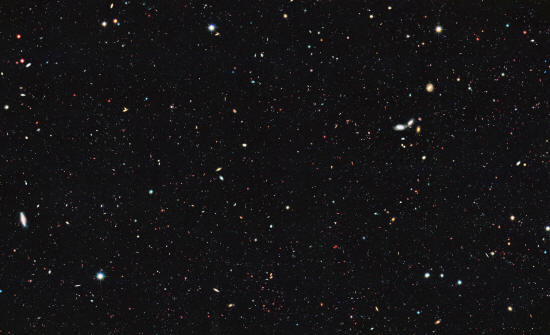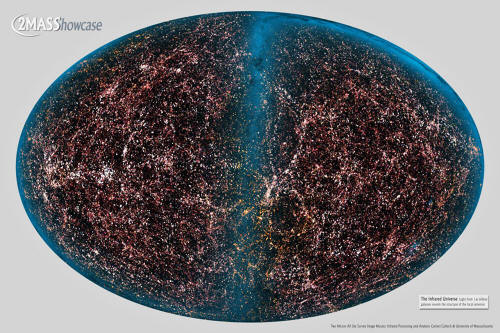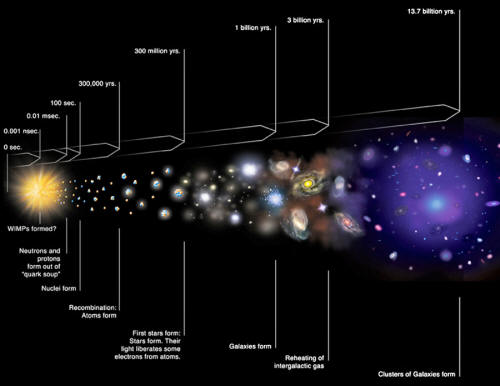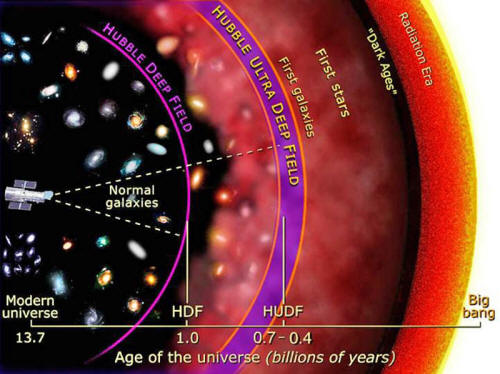|
from
Space Website
More than a trillion galaxies are
lurking in the depths of space, a new census of galaxies in the
observable universe has found - 10 times more galaxies than were
previously thought to exist.
An international team of astronomers used deep-space images and other data from the Hubble Space Telescope to create a 3D map of the known universe, which contains about 100 to 200 billion galaxies.
In particular, they relied on Hubble's Deep Field images, which revealed the most distant galaxies ever seen with a telescope.
Then, the researchers incorporated new mathematical models to calculate where other galaxies that have not yet been imaged by a telescope might exist. For the numbers to add up, the universe needs at least 10 times more galaxies than those already known to exist.
But these unknown galaxies are likely either too faint or too far away to be seen with today's telescopes.
Looking far out into deep space also means looking back in time, because light takes a long time to travel across cosmic distances.
During the study, Christopher Conselice and his team looked at parts of the universe up to 13 billion light-years away. Looking this far allowed the researchers to see partial snapshots of the evolution of the universe since 13 billion years ago, or less than 100 million years after the Big Bang.
They discovered that the early universe contained even more galaxies than it does today. Those distant galaxies were small and faint dwarf galaxies, they found.
As the universe evolves, such galaxies merge together to form larger galaxies.
In a separate statement, Conselice said that the results are,
The results of the study (The Evolution of Galaxy Number Density at z<8 and its Implications) are detailed in The Astrophysical Journal.
from
UniverseToday Website
as many as 2 trillion galaxies in the known Universe.
Credit: 2MASS/Caltech
Ever since human beings learned that the Milky Way was not unique or alone in the night sky, astronomers and cosmologists have sought to find out just how many galaxies there are in the Universe.
And until recently, our greatest scientific minds believed they had a pretty good idea - between 100 and 200 billion.
However, a new study produced by researchers from the UK has revealed something startling about the Universe. Using Hubble's Deep Field Images and data from other telescopes, they have concluded that these previous estimates were off by a factor of about 10.
The Universe, as it turns out, may have had up to 2 trillion galaxies in it during the course of its history.
Led by Prof. Christopher Conselice of the University of Nottingham, U.K., the team combined images taken by the Hubble Space Telescope with other published data to produced a 3-D map of the Universe.
They then incorporated a series of new mathematical models that allowed them to infer the existence of galaxies which are not bright enough to be observed by current instruments.
Scientists from the UK have produced new estimates on the number of galaxies in the Universe, which could shed light on cosmic evolution as well. Credit: NASA/Chandra
Using these, they then began reviewing how galaxies have evolved over the past 13 billion years.
What they learned was quite fascinating...
For one, they observed that the distribution of galaxies throughout the history of the Universe was not even. What's more, they found that in order for everything in their calculations to add up, there had to be 10 times more galaxies in the early Universe than previously thought.
Most of these galaxies would be similar in mass to the satellite galaxies that have been observed around the Milky Way, and would be too faint to be spotted by today's instruments.
In other words, astronomers have only been able to see about 10% of the early Universe until now, because most of its galaxies were too small and faint to be visible.
As Prof. Conselice explained in a Hubble Science Release, while may help resolve a lingering debate about the structure of the Universe:
Illustration of the depth by which Hubble imaged galaxies in prior Deep Field initiatives, in units of the Age of the Universe. Credit: NASA and A. Feild (STScI)
To break it down, the "top-down model" of galaxy formation states that galaxies formed from huge gas clouds larger than the resulting galaxies.
These clouds began collapsing because their internal gravity was stronger than the pressures in the cloud. Based on the speed at which the gas clouds rotated, they would either form a spiral or an elliptical galaxy.
In contrast, the "bottom-up model" states that galaxies formed during the early Universe due to the merging of smaller clumps that were about the size globular clusters. These galaxies could then have been drawn into clusters and superclusters by their mutual gravity.
In addition to helping to resolve this debate, this study also offers a possible solution to the Olbers' Paradox (aka. "the dark night sky paradox").
Named after the 18th/19th century German astronomer Heinrich Wilhelm Olbers, this paradox addresses the question of,
Based on their results, the UK team has surmised that while every point in the night sky contains part of a galaxy, most of them are invisible to the human eye and modern telescopes.
This is due to a combination of factors, which includes the effects of cosmic redshift, the fact that the Universe is dynamic (i.e. always expanding) and the absorption of light by cosmic dust and gas.
Image was taken by the NASA/ESA Hubble Space Telescope which covers a portion of the southern field of Great Observatories Origins Deep Survey (GOODS). Credit: NASA/ESA/HST
Needless to say, future missions will be needed to confirm the existence of all these unseen galaxies...
And in that respect, Conselice and his colleagues are looking to future missions - ones that are capable of observing stars and galaxies in the non-visible spectrum - to make that happen.
Understanding how many galaxies have existed over time is a fundamental aspect of understanding the Universe as a whole.
With every passing study that attempts to resolve what we can see with our current cosmological models, we are getting that much closer...!
|





